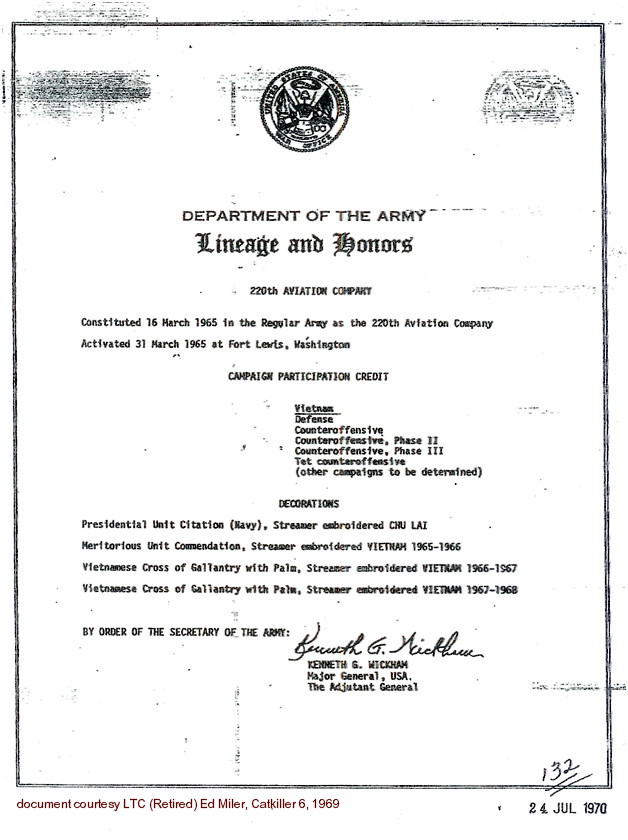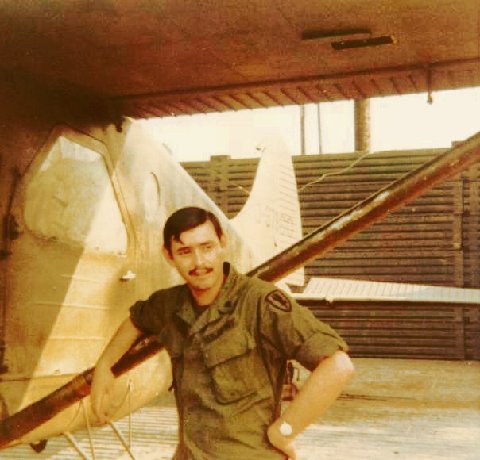CATKILLER HISTORY, 1970:
In 1969, Major Ed Miler commanded the 220th Recon Airplane Company, until 4 July 1969. On 27 April 2010, LTC Ed Miler (Retired) compiled and self-published a very nice pictorial snapshot of the unit, The 220th Recon Airplane Company, Vietnam, 1968—1969, The "Catkillers" of the DMZ, citing numerous photographs with accompanying text. I am honored to have a gift copy for record. Page three of this 43-page booklet/pictorial snapshot contains the following mission statement:
The 220th Reconnaissance Airplane Company, the Catkillers
--- Mission Statement ---
“Catkillers, Guardians of the DMZ, Eyes of I Corps”, these are the names of the 220th RAC. Being the only Bird Dog unit in I Corps from June 1965 until January 1968 tends to give a unit such as the 220th many nicknames. Under the operational control of the Third Marine Division, the 220th served almost every type of unit in I Corps. The 101st Airborne Division, 1st ARVN Division, 108th Artillery Group, 5th Mechanized Division, and the Naval Task Force off the coast of Vietnam all utilized the services of the 220th Bird Dogs. The mission was initially to find the enemy, the NVA and the Viet Cong, report their positions to the supported units, and direct the US forces to engage the enemy, and to adjust artillery fire on the enemy. The mission was broadened to suit the wishes of the supported Marine Corps units to include fire direction for Marine, and Air Force fighter/bomber aircraft, as well as to call for and adjust the fire of Navy ships off the coast. This added mission made the 220th unique among all of the Recon Airplane companies, 19 of them, in Vietnam. When fire direction missions were needed north of the DMZ, the 220th was there first with its O-1 aircraft. They served as eyes for the guns in the south. Flying over 850 missions per month, the “Catkillers” located the enemy and called in the firepower to complete the job.
Historically, an interesting document surfaced in LTC Miler's publication: A official order stating the Lineage and Honors for the unit, dated 24 July 1970:

The above letter order will also be placed at the first history page for 1965.
Ed Miler produced his document at a local publications business close to his home, and he states that he will make these available at his cost, which is $20 delivered (as of May 2010). If you desire to have a copy of this excellent individual effort, contact Catkiller 6. Ed Miler's e-mail address is available from the editor or from Bob McComiskie:
"I have put together this paper which I once described as a photographic journey with the Catkillers, during the time I was the CO in 1969. This booklet was inspired by Jim Hooper’s book, A Hundred Feet over Hell, and is designed to complement and to be a supplement to his book. It was motivated by a question asked by one of my children, "Dad, what did you do in Vietnam?" The book is certainly not about me; it is about the men who flew the flimsy, unarmed, and very slow Cessna O-1 "Bird Dog" aircraft into harm’s way every day; the brave and fearless men of the 220th RAC. Since the booklet was originally to be for my children and grandchildren, there are a number of photos of me on its pages. I trust that you will forgive that little self-indulgence!
Jim’s book is extremely well written, and has become very important to me, as it has rekindled many long dormant memories which I thought were gone forever. Memories of the hangar full of stolen stuff; of Don Long and the "bird strike" incident; of my right hand—the always steady and reliable XO—Russ Blanchard, who was killed in a car accident a few years after his retirement; and of Blanchard and me carrying the passed out First Sergeant to the bunker during a mortar attack. But most important of all, the book has brought back memories of you Catkillers, you "Band of Brothers", to borrow the title from one of Ernest K. Gann’s books.
Best wishes,
Ed Miler
Catkiller 6, 1969"
Donald M. Ricks, Editor
FLIGHT OPERATIONS:
"I was a SP4 in the unit from Jan—Dec, 1970. I spent my first two months or so as the first radio teletype operator (after we set up the radio teletype unit and strung the antenna with guidance from a General Dynamics consultant who spent time with us). The last 9 or 10 months of my tour, I was the graveyard flight operations/air traffic control specialist.
Richard Phillips [Photo of Richard below]"





